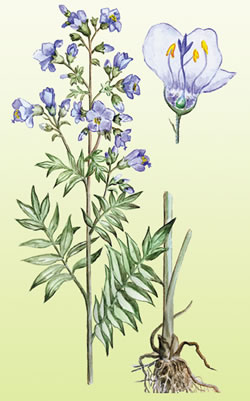Cyanosis blue – TALL blue
Perennial herbaceous plant of 80-100 cm, families sinyuhovыh (Polemonium). It grows in the forest and steppe zones. For medical purposes, harvest the rhizome with roots in August - September.

Chemical cyanosis blue composition
Rhizomes and roots of cyanosis blue contains 20-30 % triterpene glycosides, resinous substance, organic acid, ethereal and fatty oils. The chemical composition of cyanosis has not been studied.
Pharmacological properties cyanosis blue
Due to the presence of large amounts of plant saponins (triterpene glycosides) decoctions and infusions of cyanosis were introduced into medical practice as an expectorant to replace senega.
In preparations cyanosis were detected expressed soothing properties. Broth and tinctures from the roots and rhizomes of cyanosis reduce locomotor activity, reflex excitability, inhibit the behavioral response indicative of animals in experiments. Sedation plants was more pronounced in animals, subjected to prior action of CNS stimulants (eg, fenamina). As sedative activity of the drug cyanosis 8-10 times higher than the effect of valerian.
Study of the pharmacological properties of the sum of triterpene glycosides cyanosis confirmed, The biological activity of the plants depends on the quantity contained these chemicals.
Application of cyanosis blue in medicine
Clinical study of the effectiveness of broth and extract rhizomes and roots of cyanosis blue conducted in patients, suffering from acute and chronic bronchitis, bronchopneumonia and lung abscesses. More than 50 % patients had noted positive dynamics of the disease is already at 3-4 days after the start of treatment. In exchange treatment for 30 days decreased inflammation in the lungs, cough becomes softer, facilitated sputum, pain disappeared.
In therapeutic studies cyanosis as an expectorant found, that this plant is not only not inferior to similar actions senega, but surpasses it in some therapeutic effect, especially chronic and acute bronchitis. When using cyanosis in patients with pulmonary tuberculosis were observed hemoptysis while taking infusions and plant extracts, although there was a tendency to hemoptysis to the drugs. This fact confirms the existence of the plant properties, increase blood clotting.
Clinical study of sedative properties cyanosis held in a psychiatric hospital. The drug is prescribed to patients excited, insomniacs. Upon receipt of cyanosis within 2-3 weeks, patients became significantly quieter, they have normal sleep. Sedation medications cyanosis is similar in nature to the action of medicinal properties valerian.
For the treatment of patients with gastric ulcer and duodenal ulcers used a combination of two herbs - cyanosis blue, Sedative activity, and uliginose, provider of wound healing, regenerative effect. Combined method of treatment of peptic ulcer disease was the most effective in patients with increased secretory activity of gastric juice.
Preparations low toxicity cyanosis, prolonged their use does not cause side effects.
Formulations, Dosing and Administration cyanosis blue
Infusion of rhizomes and roots of cyanosis blue prepared as follows:: 6 g (2 tablespoons) raw material is placed in an enamel bowl, Pour 200 ml (1 glass) hot boiled water, capped and heated on a steam bath for 15 m, cooled at room temperature for 45 m, filter, the remaining raw materials squeeze. The volume of the resulting infusion was adjusted with boiled water to 200 ml. As an expectorant used for 1 tablespoon 3-5 times daily after meals. At a stomach ulcer - at 1 tablespoon 3 times a day after eating at the same time infusion uliginose.
The raw material stored in a dry, cool place. The prepared infusion stored in a cool place no more than 2 d.
